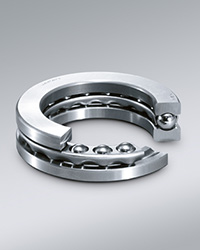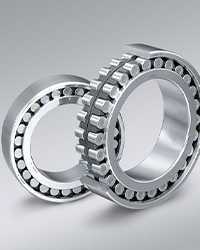NSK Angular Contact Ball Bearings
The NSK range of angular contact ball bearings has been designed to meet the increasingly demanding requirements of original equipment manufacturers.
These bearings have a contact angle to sustain significant axial loads in one direction together with radial loads.
Furthermore, since an axial component is generated when a radial load is applied, these bearings are generally used in pairs, triplex sets, quadruplex sets, or multiplex sets.
NSK offers one of the most comprehensive ranges of angular contact ball bearings available.
Features- High-Quality Steel — Ultra clean steel to extend bearing life by up to 80%.
- Advanced Grease Technology — NSK lubricants that can extend grease life and performance.
- High-Grade Balls — Quiet and smooth operation even at high speed.
- Super Finished Raceways — Specially honed to minimize noise and improve lubricant distribution and life.
- Contact Angle — Offered in 15, 25, 30, and 40-degree angles.
- Cages — Available in a range of Polyamide, steel, and brass cage assemblies.

NSK Self-Aligning Ball Bearings
This ball bearing type is recommended when the shaft and housing alignment is complex and the shaft may flex. The outer ring has a spherical raceway, and its center of curvature coincides with that of the bearing; therefore, the axis of the inner ring, balls, and cage can deflect to some extent around the bearing center. Pressed steel cages are usually used.
Since the contact angle is slight, the axial load capacity is low. Under normal loads, the permissible dynamic misalignment is approximately 0.07 to 0.12 radian (4 to 7 degrees).
However, such an angle may not be possible depending on the surrounding structure.

NSK Thrust Ball Bearings
Thrust ball bearings are classified into those with flat seats or aligning seats depending on the shape of the outer ring seat (housing washer). They can sustain axial loads but no radial loads.
For Single-Direction Thrust Ball Bearings, pressed steel cages and machined brass cages have usually used. The cells in Double-Direction Thrust Ball Bearings are the same as those in Single-Direction Thrust Ball Bearings of the same diameter series.
Features- Available in two designs: single direction and double direction.
- To accommodate initial misalignments in an assembly both designs are available with spherical aligning seats or aligning seat washers.
- High-quality steel-ultra clean steel to extend bearing life by up to 80%.
- Advanced Grease Technology — NSK lubricants that can extend grease life and performance.
- High-Grade Balls — Quiet and smooth operation even at high speed.
- Optional seating rings take initial misalignment.

NSK Cylindrical Roller Bearings
The cylindrical rollers are in linear contact with the raceways in bearings of this type. They have a high radial load capacity and are suitable for high speeds.

NSK Tapered Roller Bearings
Bearings of this type use conical rollers guided by a back-face rib on the cone. These bearings can take high radial loads and axial loads in one direction.
In the HR series, the rollers are increased in size and number, giving them an even higher load capacity. They are generally mounted in pairs like single-row angular contact ball bearings.
In this case, the proper internal clearance can be obtained by adjusting the axial distance between the cones or cups of the two opposed bearings. Since they are separable, the cone assemblies and cups can be mounted independently.

NSK Spherical Roller Bearings
Using bearings with oil grooves and holes, experts suggest providing an oil groove in the housing bore since the depth of the groove in the bearing is limited.

NSK Needle Roller Bearings
Needle roller bearings are a bearing that is classified as either radial or thrust depending on the direction of the load being supported. Needle roller bearings include bearings whose rollers slightly exceed the size range of needle rollers as stipulated by ISO.
Needle roller bearings include drawn cup and solid radial bearings and application-specific cam followers and roller followers. Thrust bearings have thrust needle bearings.

NSK Super Precision Bearings
- This bearing lineup includes a primary series that meets ISO standards and a specified series targeting machine tools.
- A double-row cylindrical roller bearing series is available for applications requiring high rigidity. A single-row cylindrical roller bearing series is available for applications requiring high-speed performance.
- A Robust™ series of high-performance bearings are available for applications requiring both high-speed and high-rigidity performance.

- The highly rigid series for machine tool applications has been designed to provide sizeable axial rigidity and precise rotation with lower starting torque.
- The highly rigid series is available with a lubricant seal for machine tool applications.
- The high load capacity series for electric injection molding machines offers enhanced service life by using optimally designed ball diameter and contact angle for a higher load rating.

- Ball bearings achieve high running accuracy and low torque rotation.
- High moment stiffness on a par with crossed roller bearings.
- Exclusive design of the thin cross-section profile is thinner than that of a standard angular contact ball bearing.

- This lineup of bearings includes a basic series that meets ISO standards and a specified series targeting machine tools.
- A series of sealed angular contact ball bearings with prepacked grease is available.
- The Robust™ series of high-performance bearings includes a wide lineup ranging from highly rigid to ultrahigh-speed types.
